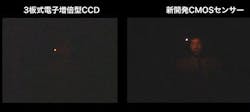Canon unveils high-sensitivity CMOS video sensor

Tokyo, Japan--Canon has developed a 35 mm CMOS sensor dedicated to video shooting in low light.
The sensor's pixels are 19 x 19 μm in size -- an area 7.5 times larger than for the pixels in the CMOS sensor used in Canon's highest-end digital single-lens reflex camera. The pixel-readout circuits for the new sensor have been improved to reduce noise, which tends to become more of a problem as pixel size increases.
The new sensor enables to take clear video even with an illuminance of about 0.03 lux -- equivalent to the illuminance of the light of the crescent moon. In a comparative example, an electron-multiplying CCD (EMCCD) with a sensitivity equivalent to that of the naked eye can take video of stars of up to the sixth magnitude; however, the new CMOS sensor can take video of stars to the 8.5th magnitude or more, according to Canon.
Video of room lit by an incense stick
Canon's CMOS sensor was used to take a video in a room in which the only light source was an incense stick (about 0.01-0.05 lux); a still from the video is seen below (right), compared to a still from an equivalent video taken with an EMCCD (left).
The sensor is aimed at astronomical and nature observation, medical research, and monitoring and security devices. Canon is showing a prototype of a camera equipped with the new CMOS sensor, as well as videos taken by the camera, in Canon Marketing Japan Inc.'s booth at the Security Show 2013 (March 5 to 8, 2013; Tokyo).
Source: http://techon.nikkeibp.co.jp/english/NEWS_EN/20130305/269513/

John Wallace | Senior Technical Editor (1998-2022)
John Wallace was with Laser Focus World for nearly 25 years, retiring in late June 2022. He obtained a bachelor's degree in mechanical engineering and physics at Rutgers University and a master's in optical engineering at the University of Rochester. Before becoming an editor, John worked as an engineer at RCA, Exxon, Eastman Kodak, and GCA Corporation.